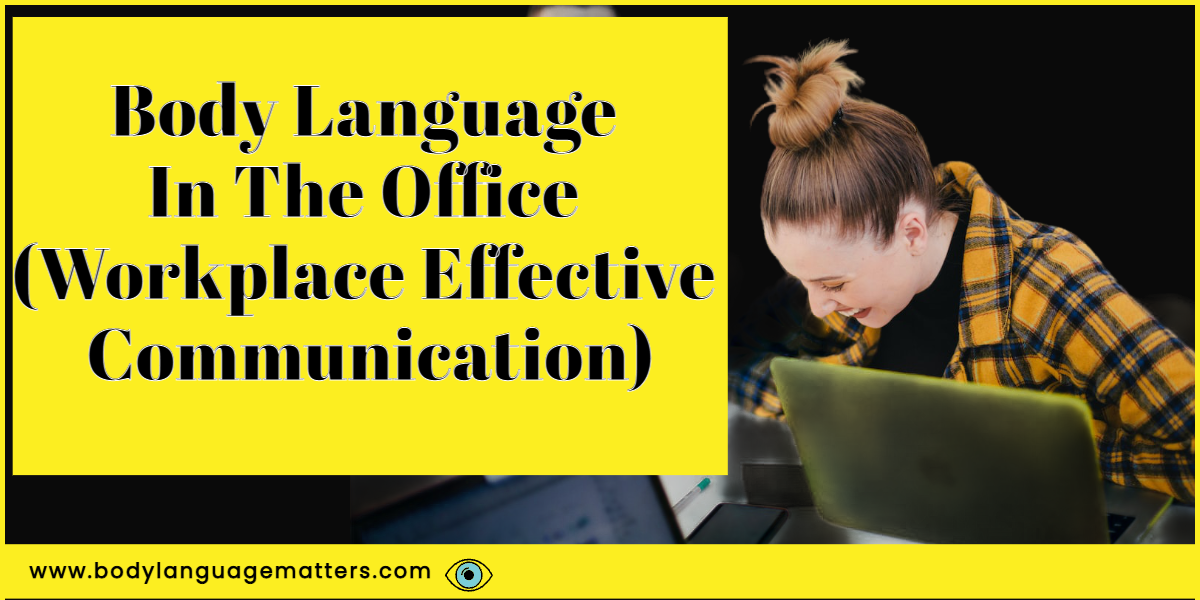It’s important to understand the basics of nonverbal communication in order to thrive in the workplace. Reading body language cues is great for making your day less stressful and can help with advancing your position or making sure you’re responsive enough at meetings.
To fully understand how to read someone’s body language in the office you first have to understand a few basic principles.
To understand a person, you need to get a context, social structure, and baseline first. Sensing changes in behavior is one of the more reliable ways to detect when something is up. First up we will look at what body language means, then context and after that the baseline of a person.
What is body language?
Body language is a form of nonverbal communication in which physical behaviors, such as facial expressions and gestures, are used to communicate messages. Body language mistakes, such as crossing your arms or not making eye contact, can cue others to perceive you as angry, nervous, or untrustworthy. Paying attention to your body language can help you communicate effectively and avoid misunderstandings. For more information on how to read body language, we strongly recommend you read How To Read Body Language & Nonverbal Cues (The Correct Way) this will give you a good understanding of how to analyze coworkers.
Understand Context From A Body Language Point Of View.
According to Google, the noun context can be described as “the circumstances that form the setting for an event, statement, or idea and which it can be understood.”
This is an example of how context can help us understand each other. If we pay attention to whether they’re making jokes, upset or conflicted then we can know more about how they could be feeling.
A caveat here: “No one piece of body language will ever be able to tell us what a person really feels; there are no absolutes in body language analysis.”
Next up, we will take a look at what a baseline is and how we can use it to understand our coworkers better.
Understand A Baseline In The Office
A baseline is the set of observable behaviors that people typically display when they are in a calm state, free from external pressures.
Once you notice the subtle shift, the context of the circumstances and conversations should be taken into consideration when analyzing the person’s expression.
There are a lot of different factors that can affect how people react to each other in the workplace. Some of these include:
- Culture (indirect vs direct communication).
- Social norms (touching strangers or coworkers).
- Relationship status (spouse vs coworker).
- Personality traits (honest vs shy).
- Physical state.
All of this should be taken into consideration when forming a baseline before analyzing anyone.
A baseline is how someone acts normally without any stress – anything that deviates from a baseline is considered a data point that we need to pay attention to.
What Is Body Language In The Workplace
Body language can be a useful tool to help you communicate better in the workplace. It can help you to understand how other people are feeling or what they are thinking. If we don’t know how to do this, we might end up making mistakes and offending people. This could be even more damaging if it’s done unintentionally as we often won’t notice that anything has happened.
It’s important for us all to get better at reading body language so that we can avoid any misunderstandings and keep our relationships with colleagues and clients healthy. Body language plays a big role in how people communicate. It can mean the difference between being seen as approachable and being viewed as rude.
Body language is a great way to convey your message to an audience in a better way than just using words. It is important for people who deal with customers or clients on a regular basis. Body language can help you get your message across without having to say anything at all, which will lead to fewer misunderstandings and more clarity in the workplace.
“Did you know that 66% of communication is nonverbal.”
Next up we will take a look at positive body language.
What Is Positive Body Language In The Workplace?

Positive body language is a way of communicating with others without using words. This can be demonstrated by smiling, maintaining eye contact, staying upbeat, and being honest with gestures. Just take a look at the picture above these guys are really in sink with each other you can tell by the way they are smiling and mirroring each other.
When you display positive body language, people gravitate toward you, they mirror your behavior and want to be on your team.
In the workplace, positive body language can have a significant impact on your relationships with co-workers, bosses, and customers. It shows that you are an approachable person that is easy to talk to.
It also shows that you are competent and valuable to your employer which may make them want to keep you around for a long time or promote you within the company.
11 Positive Body Language Cues In The Workplace You Should Use.

There are a few things to keep in mind when we’re at work to make it a more positive place for all
- Smile as you walk into a room (not a fake smile people can tell this a mile off)
- Keep your hands open and around your heart and stomach.
- Greet people with a good handshake not too firm not too weak.
- Smile from the eyes.
- Tilt your head when someone is speaking (show interest)
- Stand tall.
- Keeping your hands in your pockets is not recommended.
- Keep your head held high.
- Keep your back straight when sitting.
- Lean forward when someone makes a point you agree with if seated.
- Keep good eye contact, not too much around three seconds, and break.
Why Should You Smile as you walk into a room?
When you smile as you walk into a room, it helps to put other people at ease and let them know that you’re happy to see them. Smiling also conveys confidence, which can make people more likely to want to talk to you. So next time you walk into a room, remember to smile!
Why should you Keep your hands open and around your heart and stomach in body language?
When you keep your hands open and around your heart and stomach in body language, it shows that you are open and receptive to others. It also shows that you are comfortable with yourself and confident in who you are. This type of body language is inviting and welcoming, which makes others more likely to approach you.
Why should you Greet people with a good handshake not too firm not too weak in body language?
Greeting someone with a good handshake is important for several reasons. First, it is a way to show respect to the other person. Second, it is a way to make a good first impression. Third, it is a way to show confidence. Fourth, it is a way to show that you are interested in the other person. Finally, it is a way to show that you are friendly and approachable.
Why should you Smile from the eyes in body language?
There are many reasons to smile from the eyes in body language. Smiling from the eyes conveys warmth, happiness, and friendliness. It is also a way to show interest and engagement in a conversation. Additionally, smiling from the eyes can make you appear more approachable and trustworthy.
Why should you tilt your head to the side when someone is speaking body language?
There are a few reasons why you should tilt your head to the side when someone is speaking body language. First, it shows that you are interested in what they are saying. and second, it helps to create a more relaxed atmosphere and flowing conversation.
Why should we Stand tall in body language?
It is said that our body language accounts for up to 66% of how we are perceived by others. Therefore, it is important that we are aware of the messages our body is sending. Standing tall can convey confidence, power and authority. It can make us appear more approachable and open. Poor posture, on the other hand, can make us look weak, insecure and unapproachable. So next time you find yourself slouching, take a moment to stand up straight and see how it affects your mood and the way others perceive you.
Why is Keeping your hands in your pockets not recommended body language?
There are a few reasons why keeping your hands in your pockets is not recommended body language. First, it can make you appear closed off and unapproachable. Second, it can convey a lack of confidence. Finally, it can come across as disinterested or even rude. So if you want to make a good impression, keep your hands out of your pockets!
Why should we keep our heads held high in body language?
There are many reasons why we should keep our heads held high in body language. For one, it conveys confidence and power. When we walk into a room with our heads held high, we signal to others that we are in control and that we know what we’re doing. This can be helpful in negotiations or other situations where we need to assert ourselves. Additionally, keeping our heads held high can make us appear more attractive and approachable. It conveys openness and friendliness, which can put others at ease and make them more likely to want to talk to us. Finally, holding our heads high can simply make us feel better about ourselves. When we feel good about ourselves, we tend to project that positive energy outwards, making those around us feel good as well.
Why should we keep our backs straight when sitting with body language?
It is important to keep your back straight when sitting because it helps you to maintain good posture. Good posture is important for your overall health and can help to prevent pain in the back, neck, and shoulders. Additionally, sitting with a straight back can make you look more confident and alert, which can be helpful in both personal and professional settings.
Why Should we Lean forward when someone makes a point you agree with if seated body language?
When someone is making a point that you agree with, it is natural to want to lean forward. This is because you are interested in what they are saying and want to hear more. Additionally, leaning forward shows that you are engaged in the conversation and supportive of what the other person is saying.
Why should we Keep good eye contact in body language?
There are many reasons why you should keep good eye contact when communicating with others. For one, it shows that you are interested in what the other person is saying. Additionally, it can make you appear more trustworthy and confident. Good eye contact can also help to establish a rapport with the other person, making communication more effective overall.
Which types of body language should be avoided at work?

There are certain types of body language that should be avoided in the business world. These include poor eye contact, fidgeting, slouching, and crossing your arms. These nonverbal cues can signal nervousness or lack of interest and may make you appear unprofessional or assertive. Employees may also want to avoid using too much hand gestures, as this can be seen as a sign of excitement or nervousness. Instead, try to keep your hands at your sides or in your lap, and make sure to maintain good posture.
What Is Aggressive Body Language In The Workplace?

An aggressive body language is a form of non-verbal communication where the person uses their body to intimidate, threaten, or pressure another person.
This behavior can be seen as a form of bullying in the workplace. It includes behaviors such as standing too close, shouting in someone’s face, invading personal space, and any other form of physical intimidation.
This type of communication is often associated with unprofessionalism and should not be tolerated in any work setting. However, it is also important to remember that everyone communicates differently and this behavior may not be intended to be aggressive.
If you feel anxious or uncomfortable at work, it’s always important to speak to your HR representative. If you feel like they’re a negative influence, or that you can’t approach them without fear of retribution, it’s always a great idea to start keeping notes of times when that person has been aggressive towards you and witnesses in the room. Keep a detailed diary.
It may be hard to hear, but if you are feeling trapped at work and think you’ll never find an exit strategy, then you should start looking for another job. No one should have to feel intimidated in a professional setting.
Negative Body Language In The Workplace
Negative body language in the workplace can be defined as any type of nonverbal communication that conveys a lack of interest, hostility, or discomfort. Examples of negative body language include crossed arms, furrowed brows, averted gaze, and tight lips. This type of body language is often interpreted as a sign that the person is not open to communication or is feeling threatened. Negative body language can make it difficult to build rapport and trust with others, and it can also lead to misunderstandings and conflict.
5 Negative Body Language Cues In The Workplace.
The 5 most common types of negative body language are scowling, frowning, eye-rolling, sarcasm and rolling one’s eyes.
Scowling.
Scowling is when someone is angry and glaring at you with a tight mouth. This can be an intimidating look that makes people uncomfortable. It’s also a risk factor for anger management issues and people who are prone to violence.
Frowning.
Frowning is when someone has a negative facial expression such as sadness or unhappiness.
Sarcasm.
Sarcasm is the use of words that convey an insult or taunt in order to express scorn or mockery.
Eye-Rolling.
Eye-rolling is when someone does this while looking at the speaker as if they find them unimportant, ridiculous, disbelief or annoyance.
All of the behaviors above can be viewed as passive-aggressive, body language tells. It is worth noting how often these things tend to happen in order to get a sense of whether or not this person likes you.
There are also more negative body language cues you should avoid.
- Avoiding Eye Contact.
- Fidgeting.
- Playing with your Hair.
- Chewing gum.
- Slouching.
- Crossing your arms.
- Hands in pockets.
- Drumming fingers.
- Leaning on furniture.
- Poor posture.
Do leaders in your office have bad body language?
Do leaders in your office have bad body language? Many people in leadership positions have poor non-verbal cues. This can be negative body language such as slouching, not making eye contact, or crossing their arms. This can make it difficult for employees to approach them or feel comfortable around them. If you have a leader in your office with poor body language, it may be helpful to talk to them about it.
Which types of body language should be avoided over video conferencing?
When it comes to body lanauge and video conferencing calls over Zoom or Microsoft Teams, there are many things to avoid, but the biggest one of them all is looking down at the camera. If you position the web camera so you’re looking down at it, it can give others the impression on a subconscious level that you’re looking down your nose at people. For more on this we recommend Digital Body Language Meaning (Full Guide)
A List Of Ways People Communicate Non-Verbally Around The Work Place.
You don’t need to be a body language expert to detect some of the signals that are being given. A person can tell how you feel about them or a situation by looking at your body language gestures. They will interpret body language cues naturally.
Listed below are some of the common ways that people communicate their thoughts and feelings through their body language.
- Blushing
- Casual Dress:
- Clenched Jaw
- Deep Breathing
- Direct Eye Contact
- Ear Blushing
- Eye Blink Rate (Rapid)
- Eyebrow Flash
- Fear Smile
- Finger Pointing
- Firm Handshake
- Fist Bumping
- Flicking The Hair
- Foot Fidgeting
- Hand Clenching or Fist Clenching
- Coffee Cup Barrier or Handbag Barrier
- Hands In Pockets
- Hug
- Leg Bounce:
- Foot Fidgeting
- Leg Spreading
- Loud Voice
- Nail Biting
- Nervous Smile
- Pacing
- Palm Down Displays or Palm Power
- Quick Nod
- Scratching
- Talking Through The Hand:
- Hand to Mouth
- Arm Barrier
- Arm Crossing
- Arm Blocking
- Stiff Arm and Curved Arm
- Arm Cross With Clenched Fists
There are many body language gestures we need to consider when analyzing people in the office.
Final Thoughts
Reading other people’s body language in the office is not always easy, but it can give you a competitive edge and help you to better express your feelings. It’s kind of like a superpower that nobody else knows about. The more you practice observing, the better you will get.
We hope you have learned something from the post and enjoyed your time reading, until next time stay safe

